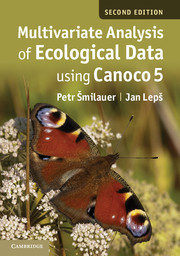Book contents
- Frontmatter
- Contents
- Preface
- 1 Introduction and data types
- 2 Using Canoco 5
- 3 Experimental design
- 4 Basics of gradient analysis
- 5 Permutation tests and variation partitioning
- 6 Similarity measures and distance-based methods
- 7 Classification methods
- 8 Regression methods
- 9 Interpreting community composition with functional traits
- 10 Advanced use of ordination
- 11 Visualising multivariate data
- 12 Case study 1: Variation in forest bird assemblages
- 13 Case study 2: Search for community composition patterns and their environmental correlates: vegetation of spring meadows
- 14 Case study 3: Separating the effects of explanatory variables
- 15 Case study 4: Evaluation of experiments in randomised complete blocks
- 16 Case study 5: Analysis of repeated observations of species composition from a factorial experiment
- 17 Case study 6: Hierarchical analysis of crayfish community variation
- 18 Case study 7: Analysis of taxonomic data with discriminant analysis and distance-based ordination
- 19 Case study 8: Separating effects of space and environment on oribatid community with PCNM
- 20 Case study 9: Performing linear regression with redundancy analysis
- Appendix A Glossary
- Appendix B Sample data sets and projects
- Appendix C Access to Canoco and overview of other software
- Appendix D Working with R
- References
- Index to useful tasks in Canoco 5
- Subject index
13 - Case study 2: Search for community composition patterns and their environmental correlates: vegetation of spring meadows
Published online by Cambridge University Press: 05 May 2014
- Frontmatter
- Contents
- Preface
- 1 Introduction and data types
- 2 Using Canoco 5
- 3 Experimental design
- 4 Basics of gradient analysis
- 5 Permutation tests and variation partitioning
- 6 Similarity measures and distance-based methods
- 7 Classification methods
- 8 Regression methods
- 9 Interpreting community composition with functional traits
- 10 Advanced use of ordination
- 11 Visualising multivariate data
- 12 Case study 1: Variation in forest bird assemblages
- 13 Case study 2: Search for community composition patterns and their environmental correlates: vegetation of spring meadows
- 14 Case study 3: Separating the effects of explanatory variables
- 15 Case study 4: Evaluation of experiments in randomised complete blocks
- 16 Case study 5: Analysis of repeated observations of species composition from a factorial experiment
- 17 Case study 6: Hierarchical analysis of crayfish community variation
- 18 Case study 7: Analysis of taxonomic data with discriminant analysis and distance-based ordination
- 19 Case study 8: Separating effects of space and environment on oribatid community with PCNM
- 20 Case study 9: Performing linear regression with redundancy analysis
- Appendix A Glossary
- Appendix B Sample data sets and projects
- Appendix C Access to Canoco and overview of other software
- Appendix D Working with R
- References
- Index to useful tasks in Canoco 5
- Subject index
Summary
In this case study, we will demonstrate a common application of multivariate analysis: search for a pattern in a set of vegetation records with available measurements of environmental conditions. The primary data (courtesy of Michal Hájek – see Hájek et al. 2002) comprise classical vegetation relevés (records of all vascular plants and bryophytes, with estimates of their cover using the Braun-Blanquet scale) in spring fen meadows in the mountain ranges of the westernmost Carpathians. The data represent an ordinal transformation of the Braun-Blanquet scale, i.e. the r, +, and 1 to 5 values of the Braun-Blanquet scale are replaced by numeric values 1 to 7. The data presented here were extracted from a database using the TURBOVEG program (Hennekens & Schaminee 2001).
The relevés are complemented with environmental data – chemical analyses of the spring water, soil organic carbon content, and slope of the locality. The ion concentrations represent their molarity: remember that predictors are standardised in all Canoco procedures and, consequently, the choice of units does not play any role, as long as the various units are linearly related. The distributions of ion concentrations are highly skewed, i.e. there are usually few highly positively outlying values, which would have a strong effect on the results. Moreover, we can expect that the vegetation composition will be better related to the logarithm of concentrations (i.e. the size of the response will be similar when we double the concentration rather than when we add a constant amount). Consequently, we have first log-transformed ion concentrations, but not the organic carbon (Corg), pH, conductivity, and slope. The transformation was done directly in the Excel file before import. We will use the log-transformed values in the analyses. The aim of this case study is to describe basic vegetation patterns and their relationship with available environmental data, mainly with the chemical properties of the spring water.
- Type
- Chapter
- Information
- Multivariate Analysis of Ecological Data using CANOCO 5 , pp. 226 - 245Publisher: Cambridge University PressPrint publication year: 2014



